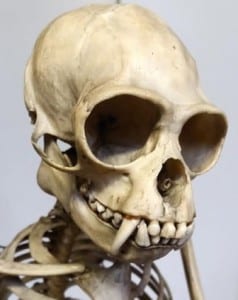Specimen of the Week 213: The Enigmatic Gibbon
By tcrnrh1, on 9 November 2015
Hello Grant Museum blog readers and zoology enthusiasts, it’s Rachel Bray here. You may be wondering who I am, unless you saw a Specimen of the Week blog by me back in May when I temporarily joined the Museum for my MA placement. I am very lucky to be back at the Grant until Christmas to work with the Museum’s wonderful learning and events programme. As part of my return I’m pleased to be getting back into the Specimen of the Week swing of things by researching this week’s candidate which is…
**a grey gibbon, Hylobates muelleri**
1) Our puzzling gibbon
The Grant has four gibbon specimens on display. The specimen proved a little tricky to identify, partly because gibbon taxonomy is pretty complex. Unlike other apes there are a surprisingly large number of gibbon species, in fact today there are believed to be nineteen in total. As you may know already, nineteen species is a far more than there are of any other apes. There is only one species of chimpanzee and one bonobo, and two species of both gorillas and orangutans. Gibbon species are divided into four genera: Symphalangus, Hylobates, Hoolock and Nomascus. With this in mind the Grant Museum collection information for the specimen reads:
‘Label states “Hylobates hoolock“, catalogue states “Hylobates mulleri” [sic] and “H. hoolock?”. Non-committal data perhaps…
2) Hoolock hoolock or Hylobates muelleri?
The first task was to solve whether the specimen was a Hoolock hoolock or Hylobates muelleri. From the main methods of differentiating gibbon species – behaviour, genetics, colour, vocalisation, morphology and geographical distribution – the latter two were clearly going to be more useful than the others due to the nature of the specimen. Firstly, judging from current understanding, the species Hoolock hoolock and Hylobates muelleri cannot be distinguished from one another by size. While Hoolock hoolock is seemingly larger and Hylobates muelleri is one of smallest gibbons, the latter can still weigh from 4kg to up to 8kg to the former’s average 7kg. Rather, it is useful that the specimen’s collection information provides some indication of geographical distribution by informing us that Sarawak, Borneo is the specimen’s collection locality. Hoolock hoolock is generally found in Assam, Bangladesh and in Myanmar, while Hylobates muelleri exist in Borneo. While recognising that such information should not be solely relied upon, owing to the limited accuracy it seems most likely that this a Hylobates muelleri.
3) Born in Borneo
Also known as the grey gibbon or Müller’s Bornean gibbon, Hylobates muelleri inhabit the northern and eastern areas of Borneo. These diurnal rainforest dwellers predominantly eat fruits and live in monogamous pairs. As with other gibbons they are renowned for protecting their family territory against intruders through a loud whooping style of singing which can resonate for almost two miles. Sadly such distinctive noises have been employed by poachers to locate and hunt gibbons. Müller’s Bornean gibbon differs from other species by not demonstrating sexual dimorphism in its fur colour. Instead, female and male Hylobates muelleri have grey or brown colouring, including a bright ring of fur around its face, and often a darkly coloured cap on the head.
4) Acrobats of the Forest
Gibbons are distinct for their mastering of brachiation, the motion of swinging from tree to tree beneath the branches. While estimates can vary considerably, it is believed that these animals can leap up to 10 metres between branches and reach speeds of around 34 miles per hour. As evident on the photographs of this specimen, the morphological traits enabling gibbons to brachiate include a short and stable lumbar spine, freely rotating wrists, long forelimbs, short fingernails, long curved fingers and reduced thumbs. If preferred, gibbons can also walk bipedally by holding their arms comically above their heads for balance. For two joyful minutes of relief from work or studying I would strongly recommend watching any video clip of gibbons walking – they’re brilliant!
5) Gibbon Recognition
Gibbons are sadly the most threatened of all primate families. Importantly, their endangered status has prompted the International Union for Conservation of Nature (IUCN) to raise awareness by allocating 2015 as the Year of the Gibbon. Further, 10th-14th November marks UCL Gibbon Week for which UCL and the Grant Museum have a whole host of events to raise awareness about these Southeast Asian apes. To find out more about the free activities happening this week please check out our What’s On Page: https://www.ucl.ac.uk/museums/zoology/whats-on and come along!
References:
Chatterjee, H. J. 2009. Evolutionary Relationships Among the Gibbons: A Biogeographic Perspective. In: Lappan, S. and Whittaker, D. (eds.), The Gibbons: New Perspectives on Small Ape Socioecology and Population Biology, pp. 13-36.
Cunningham, C. and Mootnick, A. 2009. Gibbons, Current Biology, 19: 14, pp. 543 – 544.
Encyclopedia of Life. 2015. Hylobatidae: Gibbons and Lesser Apes Overview [online]. Available from: http://eol.org/pages/1652/overview [Accessed 03.11.2015].
Encyclopedia of Life. 2015. Hylobates muelleri: Overview [online]. Available from: http://eol.org/pages/1038641/details [Accessed 02.11.2015].
Strong, S. 2015. It’s the Year of the Gibbon! [online] International Primate Protection League Official Website. Available from: http://www.ippl.org/gibbon/year-gibbon/#sthash.TkGvZnbq.dpuf [Accessed 04.11.2015]
Rachel Bray is the Learning and Events Assistant at the Grant Museum of Zoology
2 Responses to “Specimen of the Week 213: The Enigmatic Gibbon”
- 1
 Close
Close






hi Rachel—-gibbons,apart from seemingly coming from different part of world I wonder on their development—ie small size but long limbs—–why did they not get bigger (I vaguely remember a photo of skeleton of taller size (4ft?)being offered as link between humans & apes,in Victorian? times)—now because the live in tree canopies the development of long arms is advantages or was it because of their small size,but,after all there is small monkeys (marmosets) that cope with tree life—-another poser,why is there no tree dwelling predator of these (apart from snakes & birds)?